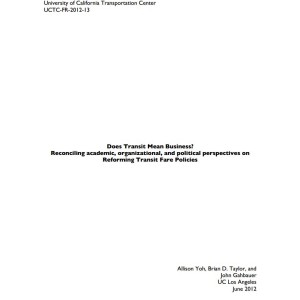
Authors: Allison Yoh, Brian D Taylor, John Gahbauer
Date: June 1, 2012
Project: [wpv-post-link id=”$project”]
Public transit systems differ from many other government enterprises in that they charge a fee, or fare, in much the way that private businesses charge for their services. Transit fares are typically of two sorts: flat or differentiated. Recent technological advances, particularly smart cards, have greatly reduced the operational and administrative obstacles to charging differentiated time- or distance-based fares. As smart cards become more ubiquitous, will transit systems gradually reverse course and begin implementing differentiated fares? Will political and institutional resistance to variable pricing hold firm, suggesting that implementation was never the principal obstacle? Or have flat fares become so thoroughly inculcated in transit practice that most transit managers are unaware of the now decades old research on the benefits of differentiated fares? This report explores these questions.
Link to Publication